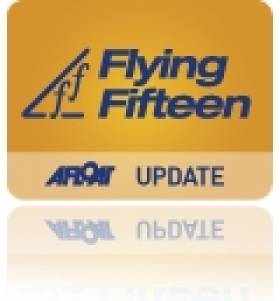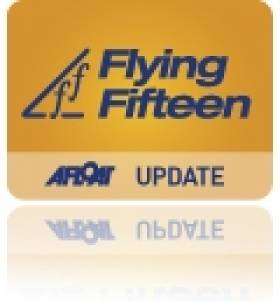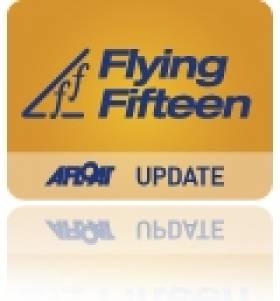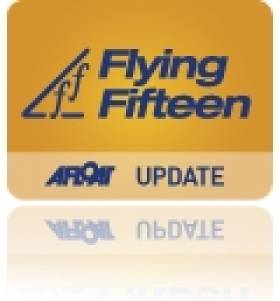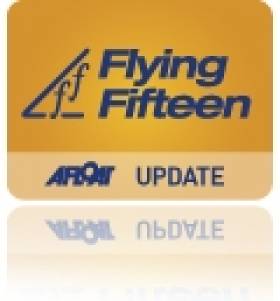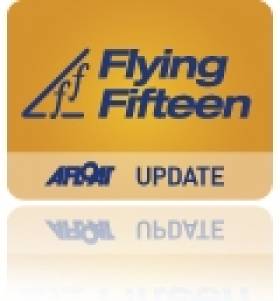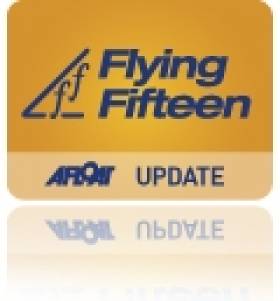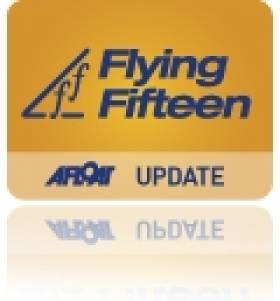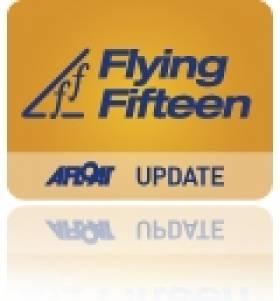Displaying items by tag: Flying fifteen
#flyingfifteen – An emphatic win for Dun Laoghaire duo John Lavery and David O'Brien on Strangford Lough yesterday keeps the Irish Flying fifteen title at the National Yacht Club in Dun Laoghaire for another year. The pair took five straight wins in the 23–boat fleet keeping the local challenge from Brian McKee and Steve Martin firmly at bay.
Racing over six races in a variety of conditions from 5-15 knots from Strangford Lough Yacht Club (SLYC) McKee and Martin in turn had a comfortable lead over club mates Roger Chamberlain and Charlie Horder in third with fellow Strangford pairing Andy McCleery and Colin Dougan of Killyleagh YC fourth.
SLYC's Aiistair and Mark Fletcher were winners of the silver fleet.
In 2011 the title was won by Dun Laoghaire's David Gorman and Chris Doorly who were not defending.
The three day event included a unique presentation of Strangford Lough archive yachting footage from the 1930s-70s. Footage included early cine reel of 12 metre and J class yacht racing from a private collection. There were rare glimpses too of early Flying fifteen keelboat competition and a talk by local sailor Peter Browne, who with brother Max, built the first Fifteen in Ireland in 1952. Early black and white images documented the boat under construction and photographs of the maiden sail on the Lough showing the boats wooden spars and cotton sails and a central winch for the jib, a chance for today's fleet to see how much the now fully carbon built Flying fifteens have changed over 60 years.
Next event for the Irish Flying fifteens is at Carrickfergus on Belfast lough on September 15th. The season ends with the East Coast Championships at the National Yacht Club on October 6th.
Strangford Pair Win Flying Fifteen Southern Title
#flyingfifteen – Strangford lough pairing Roger Chamberlain and Hammy Baker took sailed to success with two wins today to take the Flying Fifteen Southern Championship on Carlingford Lough.
Overnight leader Andy McCleery and Colin Dougan ended the regatta 4th in the 12 boat fleet after counting a seventh and eighth.
Another Strangford pairing Gerry Reilly and Tony Quail were second overall and clubmates Brian McKee and Steven Martin were third.
Full results as a jpeg for download below.
Flying Fifteens Fight it out in Carlingford
#flyingfifteen – Four points separates the top four boats at the Flying Fifteen Southern Championship after day one on Carlingford Lough yesterday.
Killyleagh's Andy McClery took two bullets to lead after three races in 14 knots. Race three saw Gerry Reilly take a tidal advantage on the right side of the Lough to take the winning gun.
The scoreboard sees Northern Ireland boats on top in the fifteen boat fleet - 1) McClery 2) Chamberlin 3) Reilly 4) McKee.
David Mulvin in sixth keeps the flag flying for the Dun Laoghaire fleet.
#flyingfifteen –The 21st July 2012 marked a milestone for the Flying Fifteen International class and its several thousand members around the world with the launch of the 4000th boat in Australia. At the same time in Scotland at the British National championships boats 4001 and 4002 were also going afloat. 4002 was launched and sailed by John Lavery and David O'Brien from the National Yacht Club and sailed to fourth overall at the Largs event.
Also in Dublin Bay, noted Dun Laoghaire helmsman Gerry Donleavy is expected to launch hull 4008 in time for the winter frostbites. The numbers represent the numbers of hulls constructed since the design came off the drawing board of legendary designer Uffa Fox in 1947.
"The coincidence of being able to allocate boat 4000 to Australia's most prolific flying fifteen builder, 83 year old Bill Shand for what may well be his own last fifteen, was a very fitting opportunity and terrific thing for the class to be able to do," said FFI Commodore Greg Wells.
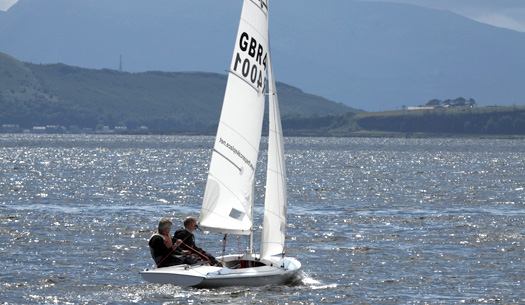
One of the very latest Fifteens, s/no 4001, sailed by Euan Dunn/ David Redpath at Largs. Photo: Alan Henderson
"To have reached this milestone, and I think be the first of the ISAF recognised international keelboat classes to do so, is something the class is extraordinarily proud to have achieved. Today is a great day in our history," he added.
Bill Shand started building Flying Fifteens' in Gipplsand, in South-East Australia in 1961, and has produced in excess 250 boats from his moulds through until 2010, owning and racing 25 of them which, other than the first one, were all called "Relience".
He has been an active player in the development and refinement of the class, with many of his boats claiming international and national championships, and regional honours over that time.
His contribution to Flying Fifteen sailing in Australia and internationally have seen him awarded life membership of the FFI Australia, and the prestigious Uffa Fox Gold Medal from FFI.
Shand picks up the story, "I had a few bits and pieces lying around my workshop a year or two ago and thought I'd build a final boat for myself. Unfortunately falling through a boat hatch and breaking some ribs slowed that idea down. Late last year I learned there was a spare spot in one of the containers coming out from the UK for the Australian 50th Nationals in Perth earlier this year. I elected to get an Ovington hull from the UK manufacturer shipped out, and drive the 7000 km round trip across the Nullabor to collect it. So this boat already has a bit of history and to be allocated the 4000 number was both unexpected and a great honour from FFI."
Over the past few months Bill has fitted a Shand keel and rudder, a Selden rig, Pinnell and Bax sails, and his usual range of fittings, systems and innovations to the boat.
On a cool winter afternoon on the 21st July 2012 on the Gippsland Lakes in Victoria, with not much breeze, long time friend and crew David Parish was on hand to help splash the ceremonial champagne, and for the launch and maiden voyage of Flying Fifteen 4000, appropriately named Relience 4K. A large group of well wishers and fellow "fifteeners" were on hand to witness the launch and celebrate the occasion with Bill.
"My 50 year journey in the Flying Fifteen Class has enabled me to meet and race against many wonderful people around the world, in a beautiful 2 man keelboat that is a delight to sail, and to have a lot of fun and enjoyment along the way" said Shand.
"Flying Fifteens are sailed on all 5 continents, in 15 countries, and over 65 years the class has formed a strong international network of country and regional associations and its world governing body, FFI. ," said Commodore Wells "The class had 110 boats at the 2011 Worlds in the UK and continues to grow at the rate of 30 to 40 new boats each year. With next year's World Championship in Hong Kong, we are keen to significantly increase our presence in South East Asia. Hopefully boat 5000 might be around for the 75th Anniversary of the class in a decade from now."
Grafham Pair Win British Flying Fifteen Title
#flyingfifteen – After a day of big winds yesterday, winds peaked briefly at six knots then disappeared, so no racing was possible today, Monday 23rd, on the final day of the Allen Flying Fifteen Nationals at Largs.
The Championship rested on the first two days of racing, in particular on the two races on Day 2, when Simon Kneller and Dave Lucas from Grafham Water SC took a win and a third place in two tricky light weather races. Very few competitors managed two good results on a difficult day.
Kneller and Lucas, improving with every race at this event, thus rose to the top of the leaderboard, to take the Allen Flying Fifteen National Championships. Kneller and Lucas were sailing in their tenth successive National Championship, and it was tenth time lucky as they landed the title for the first time.
Just two points behind, three teams were tied on six points, but the tiebreak gave Steve Goacher and Phil Evans second place, with husband and wife pairing David and Sally McKee third. Fourth in a brand new boat, launched on the first day of the Championship, were Irish visitors John Lavery and David O'Brien.
They were one of three Irish visiting boats from Dun Laoghaire, who joined Scottish, English and Welsh boats at this Championship at Largs.
Fifth were Charles Apthorp and Jonathan Clark, from Hayling Island. All five leading teams have years of experience in the class, and collectively boast many Championship titles. Racing was thus very competitive in this quality of fleet.
However those with a more relaxed attitude were also catered for, with several Silver fleet (older boats) and Classics (vintage) boats enjoying the Championship. Alex Tatlow, who sailed in the Silver fleet said, "A Silver FF is the most economic way to have a competitive boat. Silvers give excellent value for money, and need much less maintenance than many other boats. My brother and I really enjoy sailing our Fifteen at events like Cowes Week, and at Championships like this."
The Championship was well supported by sponsors, with title sponsor Allen supplying a generous range of prizes, while day sponsors Ovington, Goacher Sails, P & B and www.fotoboat.com added to the prizes. Loch Fyne supported a seafood reception and contributed prizes, while Loch Lomond Distillery provided very welcome liquid Scottish products.
This Nationals was a Qualifier event for the 2013 World Championships, and the final Worlds Qualifier event in the class will be the Scottish Championship at Loch Lomond on October 6/7, where a strong entry of over 30 boats is expected.
Results overall, Allen Flying Fifteen Nationals
Simon Kneller/ Dave Lucas, Grafham Water SC, 4pts
Steve Goacher/ Phil Evans, Royal Windermere YC, 6pts
David and Sally McKee, Dovestone SC, 6pts
John Lavery/ David O'Brien, National YC, IRL, 6pts
Charles Apthorp/ Jonathan Clark, Hayling Island SC, 8pts.
Top Scots: Hamish Mackay and Andy Lawson, Royal Highland YC in 15th overall.
Top Classic overall; Bobby Salmond/ Ingrid Magnus, Holy Loch SC in 19th overall.
Top Silver overall; Chris and Marion Bowen, Northampton SC in 24th overall.
Best boat over 7 years old; Peter and Sue Bannister, Hayling Island SC in 10th overall.
Full results on www.scottishsailinginstitute.com
Flying Fifteens Wait for Race to Complete Championships
#flyingfifteen – No racing was possible yesterday, Sunday 22nd, at Largs at the Allen Flying Fifteen Nationals.
Initial readings on the racecourse were at a fresh 16-18 knots, with gusts well above, and the wind subsequently rose to 25 to 35 knots, ruling out any racing.
Tomorrow will have two races instead of the scheduled one, to complete the Championship.
The Fifteen Nationals come to Largs every few years, and Scottish co organiser David Atwood noted a much improved Scottish entry this time of nine boats, plus many from both the NW and NE of England, as well as from further South. David said that many owners in Scotland had moved into modern boats, plus they can join in an active and very friendly Scottish
Travellers circuit which goes to many of the most scenic parts of the country.
The 2012 Scottish circuit culminates in the Scottish Championship at Loch Lomond on October 6/7, and this event will also be the final Worlds Qualifier event, so top British crews can qualify for the 2013 World Championships in Hong Kong. A strong entry of over 30 boats is expected at Loch Lomond, which has one of Scotland's biggest fleets.
At this Nationals, top Scottish boat is currently that of Hamish Mackay and Andy Lawson, in 15th overall, while Bobby Salmond and Ingrid Magnus are close behind in the first Classic (vintage) boat in 19th.
Overall standings after Day 3
1. Kneller/ Lucas, 4pts
2. Goacher/ Evans, 6pts
3. McKee/ McKee, 6pts
4. John Lavery/ David O'Brien, National YC, IRL, 6pts
Top Scots: Hamish Mackay and Andy Lawson, Royal Highland YC in 15th overall.
Top Classic overall; Bobby Salmond/ Ingrid Magnus, Holy Loch SC in 19th
overall.
Top Silver overall; Chris and Marion Bowen, Northampton SC in 24th overall.
Full results here
Kneller and Lucas Lead Flying Fifteen British Nationals
#flyingfifteen – On Day 2 of the Allen sponsored Flying Fifteen Nationals at Largs, Simon Kneller and Dave Lucas banged in two top results to move into the Championship lead but Sunday's heavy weather showdown did not materialise when racing was scrubbed as gusts hit 30-knots. Dun Laoghaire's John Lavery and David O'Brien lie fourth in the 33-boat fleet.
In light breezes, peaking around 10 knots, the first of today's two races looked like a battle of the sailmakers, as Alan Bax led all the way in style, while Steve Goacher fought off Peter and Sue Bannister to take second on the water. But Bax had been caught OCS at the start, so his apparent victory was for nought. Instead the race win went to Steve Goacher and Phil Evans, with the Bannisters second and Simon Kneller/ Dave Lucas in third.
Kneller's rise to the front continued in the second race with a race win to give him the best scoreline of the day, lifting him above Goacher overall after three races.
It was a hard fought victory, as he finished just two boat lengths ahead of second placed David and Sally McKee, who also rose up the leaderboard today. The day's results set up a very tight leaderboard, with four teams separated by just two points, at the halfway mark of the Championship. The stage is set for an exciting climax to the Championship over the next two days at Largs.
Last night the competitors enjoyed a seafood buffet and whisky, courtesy of hospitality sponsors Loch Fyne and Loch Lomond Distillery whisky.
At the reception, the class is celebrating passing a major milestone, of sail number 4,000. The two very latest boats sail number 4001 and 4002 were launched at this Championship. But the Championship and class also includes many older boats, the vintage Classics and the rather younger Silver fleet.
The class encourages both these fleets, ensuring long competitive life for older boats.
Results, Race 2, Calypso Cup
1. Steve Goacher/ Phil Evans, Royal Windermere YC
2. Peter and Sue Bannister, Hayling Island SC
3. Simon Kneller/ Dave Lucas, Grafham Water SC
Results, Race 3, John Clark Trophy
1. Kneller/ Lucas
2. David and Sally McKee, Dovestone SC
3. Adrian Tattersall/ Tim Smart, Parkstone YC
Overall after Day 2
1. Kneller/ Lucas, 4pts
2. Goacher/ Evans, 6pts
3. McKee/ McKee, 6pts
4. John Lavery/ David O'Brien, National YC, IRL, 6pts
Top Classic overall; Bobby Salmond/ Ingrid Magnus, Holy Loch SC in 19th overall.
Top Silver overall; Chris and Marion Bowen, Northampton SC in 24th overall.
Full results here
Green and Doorly Take FF Frostbite Title
#FLYING FIFTEEN – It was dubbed 'Super Sunday' as four boats were in contention going into week six of the National Yacht Club's Frostbite series for Flying Fifteens and with two races slated it was all up for grabs.
Green/Doorly (23pts) in their boat Deranged had a one point advantage from Mulvin/Beirne and Poole/Marsden who were both on 24 points with Coleman/Quinn on 25. Being November a reasonable breeze was expected but no... on arrival to the club the sun was shining and Dublin Bay was flat calm!
PRO Ian Mathews, who had done a fantastic job for the event, went out to check the bay and after a short delay decided to abandon sailing for the day, this proved to be the correct decision as the wind never filled in. However, the first race of the DMYC dinghy frostbites did manage to sail a course set inside the harbour later in the afternoon.
Ten races were sailed in what was an excellent series, a feature of the racing was that there was a different winner in nearly every race, Ken & Hugh were the only one's that won two races. At the prize giving the Mermaid class (who organized the event) captain Tony O'Rourke thanked the sponsors, the NYC boathouse, the PRO and his team including the excellent rib drivers and mark layers. Alan Green thanked them also and also thanked his fellow competitors and his crew for the series Chris Doorly.
Five Regional Events Planned for 2012 Flying Fifteen Season
#FLYING FIFTEEN – At Monday's Irish Flying Fifteen Fleet AGM at East Antrim Boat Club 2012's sailing fixtures were agreed with five regional events planned. The cost of new boats now running to €20k was seen as a deterrent to new members but as a means of promoting the class a suggestion was made to hold an open evening at events to try to encourage new blood using four or five boats.
2012 Fixtures
May 19-20 Northern Championships - Strangford SC
June 23-24 or 15-16 Sept Southern Championships - Carlingford
Aug 17-19 Championship of Ireland - Strangford Lough YC
TBA West Coast Championship - Carrickfergus SC
Oct 6-7 East Coast Championship - National YC
July 20-23 British Championships - Largs SC
Aug 27-31 European Championship - Lake Garda
Green and Doorly lead Flying Fifteen Frostbite Series
There are over thirty boats entered with over 20 of them Flying Fifteens, quiet an impressive turnout leading some to conclude that maybe we should be sailing more in the winter when there are less distractions!
After four races and one discard Green/Doorly lead the way along with McCambridge/Murphy with Poole/Marsden in third place. There have been plenty of thrills and spills and PRO Ian Mathews and his team have had their work cut out to keep things running smoothly but smooth it has been with excellent courses and racing.
The first week was cancelled due to light winds and on week 2 we just got one race in between squalls of 30 plus knots! This became survival and the PRO took the sensible and correct options of cancelling the remaining races. In Race 1 the lead changed a few times with Crummy Burgess leading at the final weather mark but hit it allowing Green to nip in and take the gun on a shortened course. Dooley/Hickey were second with McCambridge/Murphy third. Some of the crews had plenty of practice bailing out but all survived!
Race 2 took place on Sunday on a sunny day in a nice force 3 in west/south west shifty winds with the tide coming in. The fleet were a bit over eager and eventually after a couple of general recalls the black flag came out, this still didn't stop a number of boats including Crummy, Dumpleton, Sherry and O'Sullivan been over! Coleman/Quinn lead from McCambridge/Murphy followed closely by Green and Poole. McCambridge got the lead on lap two and held it comfortably to take the gun Green had moved into second place but approaching the committee boat got a sudden lift but couldn't release the main and was heading to weather of the committee boat, the racing was so close that after ducking back down and narrowly missing the committee boat, three boats had nipped in. Coleman was second with Murphy third and Poole fourth.
Race 2, boats got off at first time of asking Crummy lead from from Dumpleton followed closely by Doyle and Poole and McCambridge with Green back in the pack. It was nip tuck all the way with Dumpleton getting the lead at the final mark to take the gun, Crummy was second, Poole third and McCambridge fourth.
Race 3, again general recalls were the order of the day, the black flag was brought out again. Green lead at the weather mark followed by Gavin Doyle and there was a mad scramble at the weather mark with some boats totally illegally coming in on port causing havoc and ruining other peoples racing – this needs to stop, rules must be obeyed! Green was sailing with a broken tiller since race one and tacking was difficult, Doyle took advantage of this and took the lead on the last beat, Crummy had his own private wind on the last run over on the right and moved into second place with Green limping over the line in third after an eventful day. There was plenty of incidents with great racing including the usual mid fleet battles also new fleet members Robin and Susan got stuck into the racing and completed all races- an achievement in itself! We all look forward to two more races next Sunday.


























